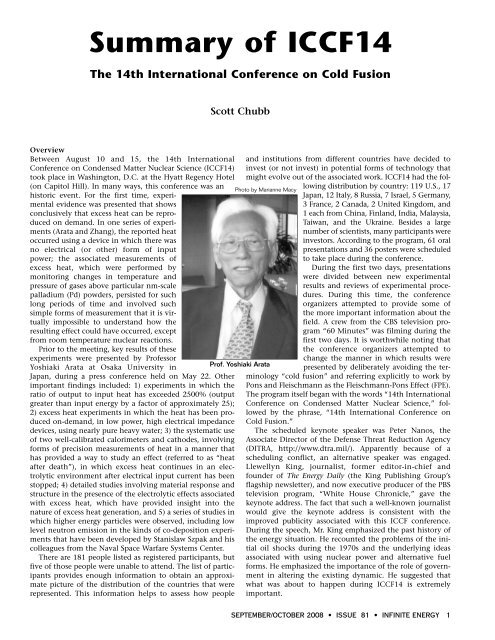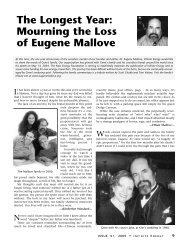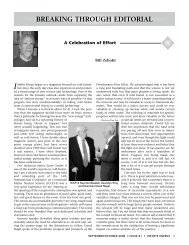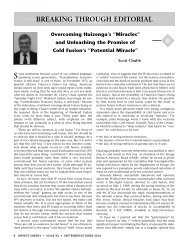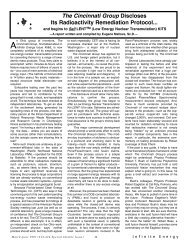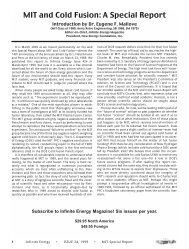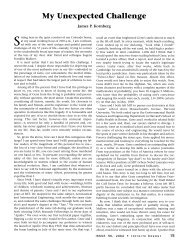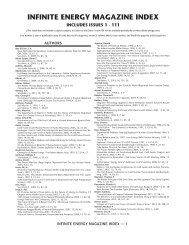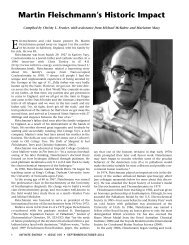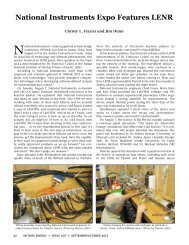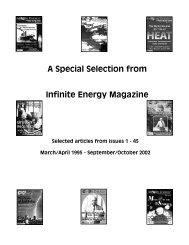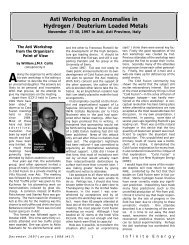Summary of ICCF14 - Infinite Energy Magazine
Summary of ICCF14 - Infinite Energy Magazine
Summary of ICCF14 - Infinite Energy Magazine
You also want an ePaper? Increase the reach of your titles
YUMPU automatically turns print PDFs into web optimized ePapers that Google loves.
<strong>Summary</strong> <strong>of</strong> <strong>ICCF14</strong><br />
The 14th International Conference on Cold Fusion<br />
Scott Chubb<br />
Overview<br />
Between August 10 and 15, the 14th International and institutions from different countries have decided to<br />
Conference on Condensed Matter Nuclear Science (<strong>ICCF14</strong>) invest (or not invest) in potential forms <strong>of</strong> technology that<br />
took place in Washington, D.C. at the Hyatt Regency Hotel might evolve out <strong>of</strong> the associated work. <strong>ICCF14</strong> had the following<br />
distribution by country: 119 U.S., 17<br />
(on Capitol Hill). In many ways, this conference was an Photo by Marianne Macy<br />
historic event. For the first time, experimental<br />
evidence was presented that shows<br />
3 France, 2 Canada, 2 United Kingdom, and<br />
Japan, 12 Italy, 8 Russia, 7 Israel, 5 Germany,<br />
conclusively that excess heat can be reproduced<br />
on demand. In one series <strong>of</strong> experi-<br />
Taiwan, and the Ukraine. Besides a large<br />
1 each from China, Finland, India, Malaysia,<br />
ments (Arata and Zhang), the reported heat<br />
number <strong>of</strong> scientists, many participants were<br />
occurred using a device in which there was<br />
investors. According to the program, 61 oral<br />
no electrical (or other) form <strong>of</strong> input<br />
presentations and 36 posters were scheduled<br />
power; the associated measurements <strong>of</strong><br />
to take place during the conference.<br />
excess heat, which were performed by<br />
During the first two days, presentations<br />
monitoring changes in temperature and<br />
were divided between new experimental<br />
pressure <strong>of</strong> gases above particular nm-scale<br />
results and reviews <strong>of</strong> experimental procedures.<br />
During this time, the conference<br />
palladium (Pd) powders, persisted for such<br />
long periods <strong>of</strong> time and involved such<br />
organizers attempted to provide some <strong>of</strong><br />
simple forms <strong>of</strong> measurement that it is virtually<br />
impossible to understand how the<br />
field. A crew from the CBS television pro-<br />
the more important information about the<br />
resulting effect could have occurred, except<br />
gram “60 Minutes” was filming during the<br />
from room temperature nuclear reactions.<br />
first two days. It is worthwhile noting that<br />
Prior to the meeting, key results <strong>of</strong> these<br />
the conference organizers attempted to<br />
experiments were presented by Pr<strong>of</strong>essor<br />
change the manner in which results were<br />
Yoshiaki Arata at Osaka University in<br />
Pr<strong>of</strong>. Yoshiaki Arata<br />
presented by deliberately avoiding the terminology<br />
“cold fusion” and referring explicitly to work by<br />
Japan, during a press conference held on May 22. Other<br />
important findings included: 1) experiments in which the Pons and Fleischmann as the Fleischmann-Pons Effect (FPE).<br />
ratio <strong>of</strong> output to input heat has exceeded 2500% (output The program itself began with the words “14th International<br />
greater than input energy by a factor <strong>of</strong> approximately 25); Conference on Condensed Matter Nuclear Science,” followed<br />
by the phrase, “14th International Conference on<br />
2) excess heat experiments in which the heat has been produced<br />
on-demand, in low power, high electrical impedance Cold Fusion.”<br />
devices, using nearly pure heavy water; 3) the systematic use The scheduled keynote speaker was Peter Nanos, the<br />
<strong>of</strong> two well-calibrated calorimeters and cathodes, involving Associate Director <strong>of</strong> the Defense Threat Reduction Agency<br />
forms <strong>of</strong> precision measurements <strong>of</strong> heat in a manner that (DITRA, http://www.dtra.mil/). Apparently because <strong>of</strong> a<br />
has provided a way to study an effect (referred to as “heat scheduling conflict, an alternative speaker was engaged.<br />
after death”), in which excess heat continues in an electrolytic<br />
environment after electrical input current has been founder <strong>of</strong> The <strong>Energy</strong> Daily (the King Publishing Group’s<br />
Llewellyn King, journalist, former editor-in-chief and<br />
stopped; 4) detailed studies involving material response and flagship newsletter), and now executive producer <strong>of</strong> the PBS<br />
structure in the presence <strong>of</strong> the electrolytic effects associated television program, “White House Chronicle,” gave the<br />
with excess heat, which have provided insight into the keynote address. The fact that such a well-known journalist<br />
nature <strong>of</strong> excess heat generation, and 5) a series <strong>of</strong> studies in would give the keynote address is consistent with the<br />
which higher energy particles were observed, including low improved publicity associated with this ICCF conference.<br />
level neutron emission in the kinds <strong>of</strong> co-deposition experiments<br />
that have been developed by Stanislaw Szpak and his the energy situation. He recounted the problems <strong>of</strong> the ini-<br />
During the speech, Mr. King emphasized the past history <strong>of</strong><br />
colleagues from the Naval Space Warfare Systems Center. tial oil shocks during the 1970s and the underlying ideas<br />
There are 181 people listed as registered participants, but associated with using nuclear power and alternative fuel<br />
five <strong>of</strong> those people were unable to attend. The list <strong>of</strong> participants<br />
provides enough information to obtain an approximent<br />
in altering the existing dynamic. He suggested that<br />
forms. He emphasized the importance <strong>of</strong> the role <strong>of</strong> governmate<br />
picture <strong>of</strong> the distribution <strong>of</strong> the countries that were what was about to happen during <strong>ICCF14</strong> is extremely<br />
represented. This information helps to assess how people important.<br />
SEPTEMBER/OCTOBER 2008 • ISSUE 81 • INFINITE ENERGY 1
The general chairman <strong>of</strong> the conference, George<br />
Washington University Pr<strong>of</strong>essor David J. Nagel, gave an<br />
introductory talk that provided an overview <strong>of</strong> what was to<br />
follow and also a context <strong>of</strong> the existing situation associated<br />
with cold fusion research. He pointed out that the study <strong>of</strong><br />
the FPE started poorly almost 20 years ago. Scientific, technical,<br />
procedural and other problems burdened the field<br />
from the outset. He stated that at the present time, imperfect<br />
reproducibility, lack <strong>of</strong> a complete theory, inadequate funding,<br />
limited communications and problems with securing<br />
patents still challenge what is intrinsically an interdisciplinary<br />
and actually quite complex subject. He said that despite<br />
such difficulties, there has been remarkable scientific<br />
progress in studies <strong>of</strong> the FPE in the past two decades.<br />
Examination <strong>of</strong> data associated with the FPE convinces more<br />
and more people that the effect is now a legitimate field <strong>of</strong><br />
science, and not a collection <strong>of</strong> mistakes.<br />
Nagel emphasized that in the present climate <strong>of</strong> higher<br />
gasoline prices, it seems appropriate to re-examine the large<br />
disparity in funding between conventional fusion research<br />
and cold fusion research. In particular, he cited the fact that<br />
$10 billion will be spent for constructing and operating the<br />
major hot fusion facility in southern France, the<br />
International Thermonuclear Experimental Reactor (ITER).<br />
Given the past history <strong>of</strong> research in this area, it seems<br />
appropriate to consider increasing the amount <strong>of</strong> funding<br />
for alternative research in cold fusion—a very good cold<br />
fusion experiment could cost $1 million, an amount that is<br />
10,000 times less than the amount projected for the ITER<br />
project. He suggested that even a minimal amount <strong>of</strong> investment<br />
(in comparison to the necessary investment that<br />
appears to be required in hot fusion) in cold fusion is called<br />
for, regardless <strong>of</strong> whether or not this research will eventually<br />
lead to a useful energy source.<br />
As opposed to the early situation involving the FPE, where<br />
the associated experimental results were initially poorly<br />
understood, it is now known that low energy nuclear reactions—which<br />
appear to be the underlying phenomena that<br />
are responsible for the FPE—have been discovered in systems<br />
involving liquids, as in the initial electrolytic experiments,<br />
in gaseous environments, and in plasmas associated with<br />
high-voltage, low-power glow discharge experiments. Nagel<br />
suggested that evidence from particle beam experiments,<br />
involving more conventional collisions between charged<br />
particles in solids at lower energies (where detailed studies<br />
have now been conducted), appear to suggest that low energy<br />
nuclear reactions might be taking place in more conventional<br />
experiments in nuclear physics.<br />
Although Nagel presented a guarded view about future<br />
prospects, he pointed out that some start-up and larger companies<br />
in the U.S. and elsewhere are now working on the science<br />
in anticipation <strong>of</strong> manufacturing power sources for<br />
sale. He said that production <strong>of</strong> energy without significant<br />
prompt radiation or residual radioactivity is a very strong<br />
motivator. It is possible that power sources varying from a<br />
few watts for portable electronics to 2 kW for home and<br />
mobile applications will result from the current research.<br />
Beyond the need for scientific understanding, current challenges<br />
include reproducibility, controllability, optimizations,<br />
scaling and reliability. It seems to most researchers dealing<br />
with the FPE that the field should be receiving significant<br />
support at a time <strong>of</strong> great concern about the large impact <strong>of</strong><br />
rising energy costs.<br />
Technical chairman Pr<strong>of</strong>essor Michael Melich, from the<br />
Naval Postgraduate School, provided an overview <strong>of</strong> the<br />
material that was to be presented at the conference. He<br />
pointed out that the first two days <strong>of</strong> the conference would<br />
give attendees who had not been following research in<br />
Condensed Matter Nuclear Science (CMNS) an opportunity<br />
to understand the breadth and depth <strong>of</strong> work that has been<br />
done since 1989. In particular, reports <strong>of</strong> recent investigations<br />
would be presented first, with the more specialized<br />
work filling the final three days <strong>of</strong> the conference. For this<br />
conference, the organizers commissioned topical reviews<br />
and also invited groups <strong>of</strong> individuals from eight different<br />
countries to write the history <strong>of</strong> research associated with<br />
CMNS in their countries; these country histories will be written<br />
in the language <strong>of</strong> each country, and later translated and<br />
edited into a compilation in English. On August 13, a brief<br />
synopsis <strong>of</strong> country histories for China, France, India, Italy,<br />
Japan, and Russia were presented.<br />
Although scheduling these kinds <strong>of</strong> talks was a departure<br />
from past practices at ICCF conferences, the idea <strong>of</strong> providing<br />
an historical overview <strong>of</strong> the subject and including<br />
reviews <strong>of</strong> important topics, at a time <strong>of</strong> heightened interest,<br />
was well-received.<br />
On Wednesday afternoon (August 13), individuals from<br />
the conference visited a new part <strong>of</strong> the Smithsonian Air and<br />
Space Museum that is located outside <strong>of</strong> Washington, D.C.,<br />
in northern Virginia. At the Wednesday evening banquet,<br />
Dr. Michael McKubre (on behalf <strong>of</strong> the International Society<br />
for Condensed Matter Nuclear Science) presented the<br />
Giuliano Preparata Medal to Dr. Irving Dardik, <strong>of</strong> Energetics,<br />
LLC, in recognition <strong>of</strong> his outstanding contributions in<br />
developing procedures for creating excess heat through the<br />
FPE. (See Dr. Dardik’s acceptance speech on p. 8.)<br />
Detailed Information<br />
Including the opening session on Monday, there were a total<br />
<strong>of</strong> 16 sessions in which oral presentations were given. The<br />
opening session (discussed above), a Wednesday morning<br />
session devoted to country histories, and the final<br />
“<strong>Summary</strong>” session on Friday morning (where a number <strong>of</strong><br />
individuals summarized what they felt were the most important<br />
results presented at the conference) were devoted to<br />
issues that were related to CMNS in more general terms. The<br />
remaining 13 sessions dealt more directly with specific<br />
aspects <strong>of</strong> the science. In addition, there were three poster<br />
sessions, which took place on Monday, Tuesday and<br />
Thursday afternoon, in which presenters talked to smaller<br />
groups <strong>of</strong> people in an informal manner about their work.<br />
After lunch on the final day, a workshop took place that<br />
dealt with a different set <strong>of</strong> topics related to nuclear transmutation.<br />
This workshop, organized by Pr<strong>of</strong>essor George<br />
Miley <strong>of</strong> the University <strong>of</strong> Illinois, was not included in the<br />
formal program <strong>of</strong> <strong>ICCF14</strong>, primarily because many <strong>of</strong> the<br />
topics still must be viewed as being speculative. (In particular,<br />
potentially new, but perhaps poorly-understood experiments<br />
related to nuclear transmutation include Mossbauer<br />
measurements that suggest a potential form <strong>of</strong> low energy<br />
nuclear reaction might take place in biological systems, for<br />
example.) At the end <strong>of</strong> this session, Pr<strong>of</strong>essor Nagel provided<br />
an interesting observation about what was presented during<br />
the workshop: 15 years ago many <strong>of</strong> the ideas associated<br />
with the FPE were also viewed as being speculative, and, by<br />
implication, it is entirely possible that with time some <strong>of</strong> the<br />
2 INFINITE ENERGY • ISSUE 81 • SEPTEMBER/OCTOBER 2008
ideas presented about transmutation during the workshop<br />
may become part <strong>of</strong> mainstream science.<br />
The most important sessions took place on Monday and<br />
Tuesday morning. On Monday, Dr. Mitchell Swartz (JET<br />
<strong>Energy</strong>) and Dr. Shaul Lesin (Energetics Technologies) presented<br />
extremely important excess heat measurement<br />
results. On Tuesday morning there were three important sessions:<br />
“Gas and Fast Loading,” “Honoring Yoshiaki Arata,”<br />
and “Honoring Stanislaw Szpak.” The most significant<br />
results were those presented during the session titled,<br />
“Honoring Yoshiaki Arata.” Many conference attendees<br />
expressed interest in the talks that were scheduled as a result<br />
<strong>of</strong> preliminary reports that had appeared in the popular<br />
press in response to a press conference (referred to above)<br />
held on May 22, in which Pr<strong>of</strong>essor Arata announced that he<br />
and Y.-C. Zhang had been able to create excess heat and<br />
helium-4, as a result <strong>of</strong> the FPE, on-demand, using a device<br />
that does not require any input power or energy once the<br />
experiment is pressurized. Prior to Arata’s presentation,<br />
Talbot Chubb provided background material about Arata<br />
and an overview and interpretation <strong>of</strong> the work.<br />
Figure 1 (from Dr. Chubb’s presentation) shows a plot <strong>of</strong> a<br />
typical time history <strong>of</strong> temperature measurements during<br />
Pr<strong>of</strong>essor Arata’s experiments. In the figure, there are three<br />
sets <strong>of</strong> curves labeled A (associated with the two upper<br />
curves), C (the third highest curve), and D. In the plots associated<br />
with A and C, the temperature is shown, as a function<br />
<strong>of</strong> time, immediately at the boundary <strong>of</strong> (in the case <strong>of</strong> A)<br />
and inside (in A and C) a nm-scale size palladium (Pd) sample<br />
in the presence <strong>of</strong> an insulating oxide, ZrO 2 , after a gas<br />
is loaded into it (by applying a pressure <strong>of</strong> ~100 atm). In the<br />
two curves associated with A, the Pd/ZrO 2 is loaded with D 2 ,<br />
and the temperature inside the sample (labeled T in ) is shown<br />
in the upper curve; immediately below this curve, a second<br />
curve is shown <strong>of</strong> the temperature (labeled T s ) at the boundary<br />
<strong>of</strong> the stainless steel flask (the subscript “s” in T s is used<br />
as a short-hand for “stainless steel”) that contains the gas<br />
and the sample. In the curve associated with C, the temperature<br />
(comparable to the highest curve associated with A,<br />
and labeled T in ) is plotted for a situation in which ordinary<br />
hydrogen, H 2 , is loaded into the Pd/ZrO 2 sample. The third<br />
plot, labeled D, shows the time history <strong>of</strong> ambient<br />
temperature <strong>of</strong> the room where the experiment was<br />
conducted.<br />
Talbot Chubb pointed out that both runs (involving<br />
D 2 in the two temperature plots associated with A,<br />
and H 2 in the plot associated with C) provide evidence<br />
<strong>of</strong> chemical heat (associated with the fact that<br />
the values <strong>of</strong> the temperature in and near the sample<br />
at the beginning <strong>of</strong> each run are greater than room<br />
temperature during the first nine hours <strong>of</strong> the experiment).<br />
He also pointed out, however, that after 10<br />
hours during the H 2 run (plot C), the temperature<br />
inside (T in ) the sample had fallen to room temperature<br />
(plot D), while a similar asymptotic behavior<br />
(either in the temperature, T in , inside the sample, or<br />
the temperature T s , at the boundary <strong>of</strong> the stainless<br />
steel flask that holds the sample) does not take place<br />
during the D 2 run (shown by the behavior <strong>of</strong> the<br />
highest two curves associated with A). In particular,<br />
after 33 hours, the average value <strong>of</strong> the “reactor temperature”<br />
T reactor ~ T s + T in<br />
2<br />
asymptotically appears to approach the limit, T reactor ~(T room<br />
+ 1.6°C), where T room is the value <strong>of</strong> the temperature <strong>of</strong> the<br />
room (associated with the plot labeled D). After approaching<br />
this asymptotic limit, T reactor remains constant for hundreds<br />
<strong>of</strong> hours.<br />
The only plausible explanation for the cause <strong>of</strong> the<br />
observed temperatures is that it occurs as a result <strong>of</strong> a nuclear<br />
reaction. In particular, the temperature difference, T reactor -<br />
T room ~1.6°C, is maintained without any external input<br />
power or input energy. The conditions associated with lack<br />
<strong>of</strong> input power and input energy which are responsible for<br />
this temperature difference are analogous to the comparable<br />
conditions that appear to be present in the temperature differences<br />
that occur in the phenomenon that has been called<br />
“heat after death” (in which excess heat persists in the<br />
absence <strong>of</strong> electrolytic input current during electrolysis<br />
experiments). However, there is an important, obvious physical<br />
difference in how the experiments are set-up: none <strong>of</strong><br />
the complicating factors (and potential sources <strong>of</strong> error)<br />
associated with electrical currents, electricity, or electrolysis<br />
are involved. The effect is triggered entirely by subjecting<br />
nm scale powders <strong>of</strong> Pd/ZrO 2 to a pressurized (~100 atm)<br />
form <strong>of</strong> D 2 gas.<br />
During the Monday morning session on excess heat,<br />
Mitchell Swartz presented results from a second set <strong>of</strong><br />
extremely important experiments, demonstrating that it is<br />
now possible to create excess heat and power, with a good<br />
redundant set <strong>of</strong> measurements confirming the excess heat.<br />
These results are also important because the techniques that<br />
he employs for calibrating, analyzing, and understanding his<br />
heat measurements have provided important information<br />
for identifying new effects and forms <strong>of</strong> heat.<br />
Swartz began his talk by describing a series <strong>of</strong> experiments<br />
performed with a low power electrolytic device that he refers<br />
to as a palladium Phusor TM . These low to moderate power<br />
devices can create low energy nuclear reactions through a<br />
process he refers to as lattice assisted nuclear reaction<br />
(LANR). He presented data showing evolution <strong>of</strong> his work on<br />
a system which “began with wires and rods,” used several<br />
metals and shapes over years and evolved to an open spiral<br />
palladium Phusor cathode. He and his co-worker Gayle<br />
Figure 1. Typical time history <strong>of</strong> temperature measurements during Arata<br />
experiments.<br />
SEPTEMBER/OCTOBER 2008 • ISSUE 81 • INFINITE ENERGY 3
Verner speculated that the “shape and orientation played a<br />
decisive role.” In a separate poster, they reported that successful<br />
LANR devices are meta-materials creating intra-palladium<br />
deuteron flow which yields the excess power gain.<br />
Swartz’s best systems use particularly purer forms <strong>of</strong> heavy<br />
water, called “High Impedance Phusors.” (This name is<br />
appropriate because these systems employ high voltages<br />
with relatively low currents.) He described results <strong>of</strong> other<br />
nickel, palladium, and titanium high electrical impedance<br />
(Pd/D 2 O/Pt, Pd/D 2 0/Au, Ni/[H 2 O] 1-x [D 2 O]x/Pt) experiments,<br />
and other experiments, involving a techniques that he refers<br />
to as “codeposition.” These codeposition experiments are<br />
different than a similar form <strong>of</strong> experiment developed by Dr.<br />
Szpak (described below) that we will refer to as experiments<br />
involving co-deposition.<br />
In particular, both Swartz and Frank Gordon (a colleague<br />
<strong>of</strong> Szpak) showed that the “codeposition” and “co-deposition”<br />
experiments can be viewed as involving two groups<br />
with distinctly different sets <strong>of</strong> phenomena (resulting from<br />
either depositing the Pd and D on a substrate involving palladium<br />
or on different substrates, such as copper, gold, silver,<br />
or platinum that do not absorb D). Swartz used the deuterium<br />
and palladium flux equations and information about<br />
deuteron loading and Pd flux to maximize the D/Pd ratio.<br />
Swartz publicly demonstrated a working model <strong>of</strong> one <strong>of</strong><br />
these Phusor LANR devices during ICCF10. It produced<br />
~230% excess energy at the multi-Watt level. During these<br />
experiments, he also demonstrated what he refers to as optimal<br />
operating point (OOP) operation. The concept involves<br />
a calibration procedure for identifying optimal loading conditions,<br />
through plots <strong>of</strong> output power as a function <strong>of</strong> input<br />
electrical power. Along with the OOP demonstration on<br />
Tuesday afternoon <strong>of</strong> the ICCF10 conference, the entire<br />
demonstration lasted five days.<br />
During situations in which excess power is generated, a<br />
natural form <strong>of</strong> filtering seems to take place in these plots, in<br />
which sharp increases in power are observed as the input<br />
power is varied over a relatively small range. He first discovered<br />
this concept <strong>of</strong> OOP by his method <strong>of</strong> detailed data<br />
analysis. Together, these kinds <strong>of</strong> plots and OOPs helped<br />
Swartz to develop his Phusor devices.<br />
At <strong>ICCF14</strong>, Swartz provided new, detailed data from measurements<br />
that were taken using these types <strong>of</strong> cells, and<br />
from newer cells that were developed later. Some were based<br />
on the first cell’s design; others included data taken from<br />
connections made to paired motors.<br />
At <strong>ICCF14</strong>, Swartz also showed results from complicated<br />
Photo by Duy Tran<br />
systems involving two cells.<br />
He referred to the heat<br />
measurement procedure<br />
employed in this new system<br />
as Dual Adjacent<br />
Calorimetry (DAC). Here,<br />
the two cells and calorimeters<br />
are placed almost adjacent<br />
to each other. The heat<br />
measurements were “dualcalibrated,”<br />
using a procedure<br />
which involves monitoring<br />
the behavior <strong>of</strong> heat<br />
flow and calorimetric<br />
instruments simultaneously<br />
in the system. He showed<br />
Mitchell Swartz<br />
results <strong>of</strong> several new types <strong>of</strong> Phusor devices using both the<br />
earlier and the newer DAC system. The devices included<br />
what he referred to as DAP-co-deposition Phusors and High<br />
Impedance Phusors.<br />
Swartz mentioned the “heat after death” (HAD) results he<br />
had obtained. He has continued to develop methods for<br />
monitoring HAD, based on data related to the thermal and<br />
electrical changes in both cells. New ways for triggering HAD<br />
appear to be possible by varying the input power (as a function<br />
<strong>of</strong> output power) so that the LANR devices approach<br />
their OOP.<br />
It is worthwhile noting (as Swartz pointed out during his<br />
talk from ICCF9) that in nickel systems, Swartz has found<br />
that by adding increasing amounts <strong>of</strong> heavy water to a normal<br />
(“light”) water cell, increased levels <strong>of</strong> excess heat can be<br />
obtained. Swartz is the only scientist, to my knowledge, who<br />
has investigated the possibility that these kinds <strong>of</strong> additions<br />
can enhance the excess heat effect, which seems to provide<br />
important information for more completely explaining the<br />
reactions. This is important because it potentially clarifies a<br />
possible origin <strong>of</strong> the excess heat results in the Ni/normal<br />
water systems. As opposed to the commonly held, intuitive<br />
idea that unusual nuclear reactions are occurring in this kind<br />
<strong>of</strong> system (as a result <strong>of</strong> the assumption that protium in the<br />
normal water is entirely responsible for the reaction), it is<br />
possible that the Ni substrate could filter or partially filter<br />
out protium, or an alternative process could be at work, in<br />
such a way that even the small (1 part in 6000) portion <strong>of</strong><br />
deuterium (and heavy water) that is present in normal water<br />
could be playing an important role in the associated reactions.<br />
Swartz employs important calibration measurements/procedures,<br />
including thermal ohmic controls, and<br />
thermal waveform reconstruction. He measures the background<br />
noise, showing it in his thermal power spectrograms.<br />
Since ICCF10 he has now supplemented these initial calibration<br />
procedures with additional controls, including<br />
paired Stirling engines and paired electricity production systems<br />
to demonstrate that usable energy is really being produced.<br />
His analysis <strong>of</strong> the heat measurements has generated<br />
important information about effects and forms <strong>of</strong> heat. In a<br />
separate talk, Swartz also reported on experiments which<br />
revealed non-thermal infrared radiation emissions from<br />
active palladium, nickel, and DAP-codeposition Phusors.<br />
Swartz points out that OOP operation is important<br />
because it has helped to improve our understanding <strong>of</strong> how<br />
to obtain excess power and provided a way to develop a<br />
more standardized procedure for comparing excess power<br />
results in different samples. He has used the procedure as a<br />
valuable tool for directing his R&D. In particular, the procedure<br />
was invaluable in the analysis that led to the development<br />
<strong>of</strong> his Phusor LANR devices and to a better understanding<br />
<strong>of</strong> the onset <strong>of</strong> excess heat and photo-effects. It is<br />
plausible that during situations in which excess power is<br />
generated, a natural form <strong>of</strong> filtering is taking place in these<br />
graphs, in V*I space, in which large increases in output<br />
excess power are observed as the input power is varied over<br />
a relatively small range.<br />
On Thursday morning, Swartz discussed a new topic that<br />
he refers to as the three region hypothesis (3RH), in which<br />
LANR reactions take place in three distinctive regions: 1)<br />
deep in a metallic lattice; 2) near the surface, and 3) in a variety<br />
<strong>of</strong> micro- and nano-meter size particles, that characterize<br />
4 INFINITE ENERGY • ISSUE 81 • SEPTEMBER/OCTOBER 2008
electro-deposited and codeposited material in palladium and<br />
palladium alloys. He suggests that each location may have<br />
differing rates <strong>of</strong> (or no) excess heat, tritium, and helium production.<br />
Swartz expands on the 3RH in this issue <strong>of</strong> IE.<br />
On Monday, Shaul Lesin (Energetics) also gave a very<br />
important talk titled, “Ultrasonically-Excited Electrolysis<br />
Experiments at Energetic Technologies.” The talk was important<br />
because Lesin discussed experiments and experimental<br />
techniques that have demonstrated a highly successful (80%<br />
success rate) procedure for reproducing the excess heat effect<br />
and at magnitudes that are considerably larger than have<br />
been observed elsewhere. Key results that Lesin discussed<br />
involved modifying surfaces: 1) using short sequences <strong>of</strong><br />
ultrasonically induced cavitation cycles (for cleaning the<br />
electrode surfaces), followed by low current density electrochemical<br />
loading, using Dardik’s superwaves and 2) cleaning<br />
the electrode surfaces by etching them using glow discharge<br />
pulses that are constructed using superwaves, and then<br />
applying electrolytic currents that are also produced using<br />
superwave forms. Superwaves consist <strong>of</strong> highly non-linear<br />
(fractal) modulation.<br />
After preparing the electrodes using ultrasound, as reported<br />
during ICCF13 by Tatiana Zilov on behalf <strong>of</strong> Emanuel Castagna<br />
(www.infinite-energy.com/images/pdfs/chubbiccf13.pdf),<br />
Energetics has found evidence <strong>of</strong> HAD. Lesin mentioned this<br />
fact, and reported information about three additional sets <strong>of</strong><br />
experiments (#56, #64b, and #64a) involving electrode pretreatment<br />
with cavitation. In 64b, they found that the maximum<br />
Coefficient <strong>of</strong> Productivity (COP) Ratio (= Output<br />
Power/Input Power= (1+Excess) Power/Input Power) was<br />
greater than 15 (Percentage Excess Power/Input<br />
Power>1400%). In experiment 64a, they found an even<br />
higher maximal COP value, COP >~25 (Excess/Input<br />
%>2400%). In experiment 56, the ratio was 8<br />
(Excess/Input%>700%). Excess heat in experiment 56 continued<br />
over the longest period <strong>of</strong> time (~300 hours), while<br />
excess heat in the other two experiments, 64b and 64a,<br />
respectively, was produced for periods <strong>of</strong> 17 and 80 hours. As<br />
a result, although the maximum COP that occurred in experiment<br />
56 was only 8, the amount <strong>of</strong> excess energy, 3.1 MJ,<br />
that was produced during this experiment was comparable<br />
to the amount, 3.5 MJ, found in experiment 64b. In the<br />
experiment (64a), where the maximum amount <strong>of</strong> power<br />
was produced, the input power was less than 1 W, and the<br />
output power was greater than 20 W.<br />
The other two Tuesday morning sessions, “Gas and Fast<br />
Loading” and “Honoring Stanislaw Szpak,” were also important.<br />
These session names, as well as “Honoring Yoshiaka<br />
Arata,” are somewhat unusual. The conference organizers<br />
were criticized prior to the event by New <strong>Energy</strong> Times’ Steve<br />
Krivit (www.newenergytimes.com/news/2008/CMNS-LENR-<br />
Update-20080804.htm) for scheduling and titling sessions<br />
that explicitly honored Szpak and Arata. Although it is<br />
unusual to “honor” an individual by using the individual’s<br />
name in the title <strong>of</strong> a particular scientific session, it is worthwhile<br />
noting that the contributions <strong>of</strong> Szpak and Arata have<br />
been extraordinary. On the other hand, the name “Gas and<br />
Fast Loading” is somewhat misleading. All three sessions, in<br />
principle, can be related to a more unifying theme associated<br />
with the potential role <strong>of</strong> smaller (micro- and nano-scale)<br />
structures in triggering the FPE. Micro- and nano-meter scale<br />
effects seem to be common in all <strong>of</strong> the associated experiments<br />
that were presented these three sessions. Further studies<br />
that focus on these kinds <strong>of</strong> structures and experiments<br />
should take place. However, the results presented in these<br />
sessions were sufficiently important that the somewhat<br />
unusual manner that they were introduced does not appear<br />
to have had a negative impact.<br />
Pr<strong>of</strong>essor Jean-Paul Biberian began the “Gas and Fast<br />
Loading” session with an overview <strong>of</strong> gas loading experiments<br />
that emphasized general features <strong>of</strong> the work.<br />
Biberian did not emphasize the importance <strong>of</strong> nanometer<br />
scale crystals in the associated effects. He did mention some<br />
<strong>of</strong> the work that he and Nicholas Armanet have done with<br />
these kinds <strong>of</strong> materials. During ICCF13 and during the<br />
“International Workshop on Anomalies in<br />
Deuterium/Hydrogen Loading in Metals,” that was held last<br />
October in Catania, Sicily, he and Armanet provided a much<br />
more complete summary <strong>of</strong> their work. Pr<strong>of</strong>essor Biberian’s<br />
knowledge and wisdom are important, and it was wonderful<br />
to hear him speak.<br />
Francesco Celani talked about related phenomena involving<br />
nm-scale materials, “Deuteron Electromigration in Thin<br />
Palladium Wires Coated with Nano-Particles: Evidence for<br />
Ultra-Fast Deuterium Loading and Anomalous, Large<br />
Thermal Effects.” He mentioned that they have been working<br />
on a variant <strong>of</strong> the approach involving the nm-meter<br />
scale Pd/ZrO 2 crystals that Arata has developed. This new<br />
procedure has been conducted at the Instituto di Nazionale<br />
di Fisica Nucleare (INFN) in Frascati, Italy.<br />
The particular experiments have involved the detection <strong>of</strong><br />
anomalous thermal effects in long (50-150 cm) and thin (50<br />
µm) Pd wires. The wires, which were coated with a mixture<br />
<strong>of</strong> salts <strong>of</strong> nm-scale materials, were fabricated from a deposition<br />
procedure that involves a thin film coating that forms<br />
from high temperature heating. The associated coating produces<br />
new forms <strong>of</strong> heat. The wires were put in a stainless<br />
steel chamber pressurized with deuterium gas that is similar<br />
to the configuration used by Arata. The chamber includes a<br />
calibration form <strong>of</strong> joule heating that involves a DC current<br />
(J=5000-50000 A/cm 2 ). The combined effect <strong>of</strong> high electric<br />
field and high temperature caused a large deuteron electromigration<br />
in the wires. After D 2 was introduced with a pressure<br />
<strong>of</strong> 5 bar, it was possible to obtain high loading very rapidly<br />
(within 6-12 s) for short periods <strong>of</strong> time, with a steady<br />
state average <strong>of</strong> 0.8 D-atoms per Pd atom, and anomalous<br />
thermal effects when large electro-migration currents were<br />
present. Apparently, the combination <strong>of</strong> using nanometer<br />
scale materials, gas-loading procedures, and wires with currents,<br />
involving high electric fields, and potential forms <strong>of</strong><br />
electro-migration, appeared to be helpful in creating a reproducible<br />
form <strong>of</strong> excess heat.<br />
In the final Tuesday morning session honoring Stanislaw<br />
Szpak, Dr. Frank Gordon and Dr. Pamela Mosier-Boss from<br />
the Naval Space Warfare Center, San Diego (NSWCSD),<br />
Larry Forsley, from JWK, Inc. (Annandale, VA), and Pr<strong>of</strong>essor<br />
Melvin Miles (Dixie State College, formerly, La Verne<br />
College, La Verne, CA, and Naval Air Warfare Center,<br />
Weapons Division, China Lake, CA) provided an overview <strong>of</strong><br />
some <strong>of</strong> the remarkable effects that have come out <strong>of</strong> pioneering<br />
ideas that Stanislaw Szpak has developed. This work<br />
involves an alternative way <strong>of</strong> creating the FPE, in which the<br />
effect is triggered electro-chemically in a way that differs significantly<br />
from what was initially done. In particular, in the<br />
co-depositional procedure suggested by Dr. Szpak, Pd and<br />
deuterium are deposited simultaneously on a substrate. As a<br />
SEPTEMBER/OCTOBER 2008 • ISSUE 81 • INFINITE ENERGY 5
consequence, high loading occurs in a very short period <strong>of</strong><br />
time, and this, after the fact, has been identified as being<br />
important. In Issue 69 <strong>of</strong> <strong>Infinite</strong> <strong>Energy</strong>, I wrote about the<br />
initial reports by Mosier-Boss, Gordon, and Szpak, and the<br />
fact they had found what must be viewed as a “smoking<br />
gun” for convincing conventional nuclear physicists that the<br />
effect associated with the FPE involves a form <strong>of</strong> nuclear<br />
reaction: the possibility that high-energy particles can be created<br />
from a room temperature process involving electrolysis.<br />
Mosier-Boss and Gordon first presented this material during<br />
a meeting <strong>of</strong> the National Defense Industrial Association<br />
at the end <strong>of</strong> July 2006. When I wrote about what they said,<br />
it was not at all clear that the effects were reproducible. Steve<br />
Krivit’s New <strong>Energy</strong> Institute sponsored the work involving<br />
independent confirmation <strong>of</strong> these results. Within six<br />
months <strong>of</strong> the time I wrote my article, results from experiments<br />
that were conducted at four separate laboratories were<br />
reported at a meeting <strong>of</strong> the American Physical Society. They<br />
appeared to provide the first confirmation <strong>of</strong> the existence <strong>of</strong><br />
the high-energy particles being emitted during the kinds <strong>of</strong><br />
experiments that had been carried out by Mosier-Boss,<br />
Gordon and Szpak, based on the (electrolytic co-deposition)<br />
procedures that they had developed. In Issue 72, I reported<br />
preliminary information about results associated with these<br />
independent confirmations <strong>of</strong> this effect.<br />
Szpak has advanced science in its truest sense through his<br />
persistence and idealism. Not only has he been creative, he<br />
has followed through with conviction, to make sure that<br />
what has happened, in spite <strong>of</strong> potential forms <strong>of</strong> hardship,<br />
has been recorded and presented openly and within the context<br />
<strong>of</strong> conventional science. Frank Gordon should also be<br />
commended for his foresight and creativity in recognizing<br />
the genius <strong>of</strong> Stan Szpak, and for encouraging and helping<br />
Pam and Stan to perform their research.<br />
In fact, new, remarkable results continue to be reported as<br />
a direct consequence <strong>of</strong> the innovative technique developed<br />
by Szpak, Mosier-Boss, and Gordon. The <strong>ICCF14</strong> session<br />
reviewed some <strong>of</strong> the material associated with their initial<br />
findings involving X-rays, tritium, and (more recently) high<br />
energy particles. They also included information about interesting<br />
morphological changes in the surfaces <strong>of</strong> their electrodes.<br />
In the three region hypothesis (3RH) paper by<br />
Mitchell Swartz that also appears in this issue <strong>of</strong> <strong>Infinite</strong><br />
<strong>Energy</strong>, there are pictures that show some <strong>of</strong> these changes.<br />
It is worthwhile noting that because <strong>of</strong> advances associated<br />
with creating images at nm-scale dimension, it is possible to<br />
speculate about the relationship between these kinds <strong>of</strong> morphological<br />
changes and changes in the local environment<br />
that potentially can be relevant to the FPE and, in more general<br />
terms, to low energy nuclear reactions.<br />
Larry Forsley provided important information about higher<br />
energy charged particles—possibly protons and alpha particles<br />
that can be related to tracks he has found in the surfaces<br />
<strong>of</strong> CR39 films, located closest to the electrodes used in<br />
the experiment and also in the same orientation relative to<br />
the electrodes, but outside the cells. Forsley spoke about<br />
potential forms <strong>of</strong> neutral particles (presumably neutrons),<br />
in tracks that he found at locations (on the back sides <strong>of</strong> the<br />
CR39 films, relative to the potential sources <strong>of</strong> high-energy<br />
particle emission associated with the electrodes). Steve Krivit<br />
has inspired an important dialogue between Larry Forsley<br />
and Andrei Lipson about subtleties with the analysis <strong>of</strong><br />
tracks in CR39 films resulting from higher energy charged<br />
particles. A somewhat remarkable effect which Forsley<br />
observed in the tracks that were created in the co-deposition<br />
experiments involves the apparent creation <strong>of</strong> three alpha<br />
particles, resulting from collisions involving a higher energy<br />
particle with a carbon-12 nucleus. It is absolutely preposterous,<br />
given the facts associated with the data that Forsley<br />
used in this analysis, to assume that the associated nuclear<br />
effects are not related to the co-deposition process which<br />
clearly is responsible for creating them.<br />
Melvin Miles also participated in the session. He discussed<br />
the fact that he had also reproduced the co-deposition effect,<br />
with excess power between 0.3 and 0.4 W. Earlier, on<br />
Monday, he also discussed subtleties associated with measuring<br />
excess power, using iso-peribolic calorimetry. In his<br />
experiments involving co-deposition, he used this form <strong>of</strong><br />
calorimetry. The fact that he performed these kinds <strong>of</strong> measurements<br />
is important because precise measurements <strong>of</strong><br />
excess power have not been made in co-deposition experiments.<br />
In particular, the fact that heat is present has been<br />
inferred in this work, using thermistor measurements <strong>of</strong><br />
temperature and indirectly from infra-red images. (During<br />
ICCF10 in 2003, in particular, the NSWCSD team presented<br />
detailed images that are available online at http://lenrcanr.org/Collections/USNavy.htm).<br />
It is quite clear that the<br />
co-deposition procedure developed by Spzak and his colleagues<br />
Gordon and Mosier-Boss is extremely important. It<br />
has and will provide vital information about the nature <strong>of</strong><br />
Photo by Duy Tran<br />
Photo by Christy Frazier<br />
Larry Forsley, Frank Gordon and Pamela Mosier-Boss<br />
Dennis Letts and Dennis Cravens<br />
6 INFINITE ENERGY • ISSUE 81 • SEPTEMBER/OCTOBER 2008
the FPE. Additional measurements involving the system are<br />
absolutely critical. These include detailed measurements <strong>of</strong><br />
heat, with precise forms <strong>of</strong> calibration, which, in my opinion,<br />
should make use <strong>of</strong> the techniques developed<br />
by Mitchell Swartz. In addition, precision<br />
measurements <strong>of</strong> d-d, nuclear products,<br />
most importantly involving helium-4, are<br />
required. Understanding the relevance <strong>of</strong><br />
excess heat and helium-4 in these experiments<br />
is essential since the associated reactions<br />
have been shown to be dominant in the<br />
other FPE experiments.<br />
Information about a number <strong>of</strong> other<br />
important experiments was also reported.<br />
Vittorio Violante, from ENEA in Rome, Italy,<br />
presented an overview <strong>of</strong> the important work<br />
that has gone on in his institution, in collaboration<br />
with Energetics, SRI, and the Naval<br />
Research Laboratory. In their work, they have<br />
been focusing on the effects <strong>of</strong> changes in<br />
materials and the role <strong>of</strong> material structure in<br />
initiating the excess heat effects. In particular,<br />
although they have not been involved with<br />
using the kinds <strong>of</strong> nm-scale materials that<br />
Arata has used, they have used probes that are<br />
capable <strong>of</strong> investigating nm-scale effects. In<br />
examining the various kinds <strong>of</strong> materials that<br />
seem to be useful, they have found that high<br />
loading is necessary but not sufficient for creating<br />
excess power.<br />
They have identified two kinds <strong>of</strong> materials<br />
that have distinctively different forms <strong>of</strong><br />
behavior that create excess heat. They refer to<br />
these materials as type “A” and type “B”. The<br />
type “A” materials created excess heat efficiently<br />
(with reproducible results occurring<br />
75% <strong>of</strong> the time at SRI and 60% <strong>of</strong> the time at<br />
ENEA) but at reduced (20% Excess Power) levels.<br />
The type “B” materials also efficiently<br />
reproduced excess power but at significantly<br />
higher levels. In particular, in two instances,<br />
these materials had a coefficient <strong>of</strong> production<br />
(=excess power/input power) <strong>of</strong> 7 (or<br />
700%) and 5 (500%). More detailed analyses<br />
indicate that the materials that appear to create<br />
greater amounts <strong>of</strong> excess power have<br />
structures that appear to have greater crystalline<br />
order in the surface regions. On<br />
Thursday, Francesca Sarto presented a talk,<br />
“Electrode Surface Morphology<br />
Characterization by Atomic Force<br />
Microscopy,” which included a detailed discussion<br />
<strong>of</strong> an analysis <strong>of</strong> the power spectral<br />
density, associated with images <strong>of</strong> the surface<br />
<strong>of</strong> heat-producing and non-heat-producing<br />
electrodes. The power spectral density which<br />
is derived from a fourier transformation <strong>of</strong><br />
images <strong>of</strong> the surface that are taken using<br />
Atomic Force Microscopy, provides a way to identify patterns<br />
in the variations <strong>of</strong> the surface morphology.<br />
The associated decomposition shows that the improved<br />
performance associated with both type B and type A materials<br />
appears to be correlated with approximate ordering on<br />
Robert Smith, Jr.<br />
Charles Beaudette<br />
Takayoshi Nohmi<br />
the surface. Samples that do not give <strong>of</strong>f excess heat effectively<br />
have random forms <strong>of</strong> orientation on the surface,<br />
while samples that give <strong>of</strong>f excess heat have preferential<br />
forms <strong>of</strong> orientation. Although this analysis<br />
is preliminary now, the technique associated<br />
with the analysis seems to be sufficiently<br />
valuable that further work involving its use<br />
appears to be warranted. These kinds <strong>of</strong> studies<br />
<strong>of</strong> materials structure and materials characterization<br />
are unique and have not been<br />
carried out elsewhere. Information from<br />
them appears to be extremely important.<br />
Other effects involving experiments associated<br />
with particle beams, i.e. work by J.<br />
Kasagi and his collaborators from Tohoku<br />
University, were presented later in the week.<br />
Also, preliminary work involving attempts to<br />
repeat experiments involving potential<br />
forms <strong>of</strong> transmutation, associated with<br />
work done at Mitsubishi Heavy Industries by<br />
Iwamura and co-workers, was discussed.<br />
There was also an interesting study by<br />
Edmund Storms involving the apparent creation<br />
<strong>of</strong> X-ray and s<strong>of</strong>t gamma ray emission<br />
involving low amounts <strong>of</strong> electrical power.<br />
David Nagel stated at the beginning <strong>of</strong> the<br />
conference that one <strong>of</strong> the factors that has<br />
impeded progress in the field is the fact there<br />
is no complete theory that describes what<br />
has taken place. This is a useful comment,<br />
but it appears to reflect confusion about the<br />
potential role <strong>of</strong> theory and, to a degree,<br />
details about what constitutes useful theory.<br />
An important point is that no serious effort<br />
appears to have been undertaken concerning<br />
this last, basic question. On Thursday, I<br />
raised this issue in more basic terms. I suggested<br />
that there have been considerable barriers<br />
to understanding what is taking place,<br />
based on preconceived notions about “existing<br />
theories” <strong>of</strong> fusion and variants <strong>of</strong> these<br />
ideas that have been suggested that might<br />
have bearing on the FPE. I suggested that in<br />
the end, the only “meaningful” theory that<br />
will be accepted must incorporate the established<br />
language <strong>of</strong> physics, which I suggested<br />
must involve conventional quantum<br />
mechanics. Confusion about quantum<br />
mechanics and its role in theoretical descriptions<br />
<strong>of</strong> the relevant physics has played an<br />
important role in the fact that at the present<br />
time an accepted, theoretical view about the<br />
phenomena does not exist. As the relevant<br />
science becomes more well defined, I am<br />
quite confident that greater theoretical input<br />
will occur, and that this will help to resolve<br />
many <strong>of</strong> the questions associated with confusion<br />
about the relevant science.<br />
I only alluded to some important beam, transmutation and<br />
other results, which I will cover in more depth in Issue 82.<br />
Preliminary planning has already begun for ICCF15,<br />
which will be held in Rome, Italy in September 2009, sponsored<br />
by ENEA and chaired by Vittorio Violante.<br />
Photo by Duy Tran<br />
Photo by Marianne Macy<br />
Photo by Christy Frazier<br />
SEPTEMBER/OCTOBER 2008 • ISSUE 81 • INFINITE ENERGY 7
Dr. Irving Dardik’s Preparata Medal Acceptance Speech at <strong>ICCF14</strong><br />
I am honored to be this year’s recipient <strong>of</strong> the Preparata<br />
Prize and thank the Committee for this recognition. Back in<br />
1991 I actually applied for a cold fusion patent based on<br />
SuperWaves. The United States patent <strong>of</strong>fice shelved it along<br />
with all the other applications that our community has submitted<br />
on cold fusion over the years. In 2001, one brave<br />
man, by the name <strong>of</strong> Pr<strong>of</strong>essor Herman Branover, stepped<br />
forward and listened to my predictions that SuperWaves<br />
would make a difference in low energy nuclear reaction<br />
results. Next in, was Ehud Greenspan who stated that even<br />
if there was a 1% chance that I was right, he would listen.<br />
After hearing me out, he upped that percentage to 50% and<br />
joined Dr. Branover, Alison Godfrey and me in a meeting<br />
with Sidney Kimmel. In a bold, daring move, Sidney<br />
Kimmel committed his personal resources to funding a<br />
SuperWaves laboratory in Israel whose mission was to use<br />
SuperWaves, in yet to be discovered approaches to produce<br />
usable energy.<br />
I am grateful to Alison Godfrey for her extraordinary leadership<br />
in building Energetics Technologies into what it is<br />
today. To Shaul Lesin for taking the lead in establishing<br />
Energetics in Israel and hiring a team <strong>of</strong> brilliant scientists in<br />
2001—now this is 10 years—long years after my patent<br />
application was filed. Their work is impeccable and has justified<br />
Sidney Kimmel’s participation. They have surpassed all<br />
expectations <strong>of</strong> what could be accomplished in a few short<br />
years using the SuperWaves.<br />
By 2003, we presented some <strong>of</strong> our early results at ICCF10<br />
and had the honor <strong>of</strong> drawing the attention <strong>of</strong> Mike<br />
McKubre. Mike’s scientific sophistication and leadership in<br />
the DARPA replication projects with SRI, ENEA and NRL has<br />
been invaluable. I also want to thank Vittorio Violante <strong>of</strong><br />
ENEA and the extraordinary team at the NRL under the leadership<br />
<strong>of</strong> Graham Hubler, for their outstanding contributions.<br />
We should all acknowledge Dave Nagel and Mike Melich<br />
for organizing an extraordinary conference here, bringing in<br />
new faces and presenting the field in a cohesive and well<br />
developed way.<br />
As Llewellyn King pointed out in his Keynote Address<br />
here, we are coming <strong>of</strong>f <strong>of</strong> a summer <strong>of</strong> skyrocketing energy<br />
costs. It is only August, and many in this country and<br />
around the world are already in fear; wondering how they<br />
will afford to heat their homes this coming winter.<br />
With all this talk <strong>of</strong> possible alternatives to the finite fossil<br />
fuel reserves, our community, our community, here, is not<br />
even part <strong>of</strong> the public dialogue. That, ladies and gentlemen,<br />
troubles me, because history teaches us that the driving<br />
forces behind the great ages <strong>of</strong> advancement, were not only<br />
people’s needs and hopes and dreams—but also our innate<br />
hunger for knowledge. Yet in the midst <strong>of</strong> this traumatic<br />
awakening to our disastrous energy crisis, our research is<br />
missing from the radar <strong>of</strong> scientific and public debate. Yet,<br />
even though our community operates virtually in the shadows<br />
<strong>of</strong> science, we are under attack and have been so for<br />
nearly two decades. But as we expend positive and negative<br />
energy to protect ourselves—struggle financially for the survival<br />
<strong>of</strong> our research—we remain at the core, strong and resolute,<br />
because this is a community <strong>of</strong> courageous people,<br />
committed against all odds.<br />
The stakes are easily articulated. The survival <strong>of</strong> civilization<br />
is dependant upon finding a safe, sustainable and readily<br />
accessible solution to the energy crisis. It is our job to<br />
remain focused on our goals and not take on a victim’s mentality,<br />
nor get caught up in the tempting web <strong>of</strong> infighting.<br />
This quiet revolution is yielding results that are more and<br />
more reproducible. We are on the verge <strong>of</strong> developing a technology<br />
that promises to rescue our future. And it is the people<br />
in this room who are going to save the world.<br />
But the revolution is now too quiet for our times. While<br />
they say we stand on the shoulders <strong>of</strong> giants, as Newton said,<br />
history is ripe with pivotal moments when the greatest<br />
minds <strong>of</strong> an age, doubted alternative thought, based on an<br />
assertion that all there was to be known was known. Make<br />
no mistake about it, we live in such a time.<br />
The greatest advances in all <strong>of</strong> science have always come<br />
from ideas that were vilified. From Galileo, to Columbus, to<br />
Semmelweis whose career was destroyed for having the<br />
audacity to suggest that physicians should wash their hands<br />
before delivering a baby. We can proudly add to that list<br />
Martin Fleischmann, Stanley Pons, and many <strong>of</strong> the people<br />
in this very room today.<br />
It is nearly impossible to fathom that<br />
despite living in the modern age where<br />
advances in science, medicine and technology<br />
arrive at seemingly lightning<br />
speed, that there are those who would<br />
argue that condensed matter nuclear science<br />
is not even worth the effort <strong>of</strong><br />
exploring. They would keep our work in<br />
the shadows, and insist that the public<br />
must not know about our research—for<br />
fear that they might share our hopes and<br />
dreams for a better tomorrow.<br />
But for those <strong>of</strong> us here tonight, I say:<br />
stay the course, because our time is now.<br />
Some members <strong>of</strong> the Energetics group:<br />
Shaul Lesin, Irv Dardik, Alison Godfrey, Vitaly<br />
Krakov, Tatyana Zilov, Ehud Greenspan, Mark<br />
Tsirlin, Arik El-Boher. Photo by Duy Tran.<br />
8 INFINITE ENERGY • ISSUE 81 • SEPTEMBER/OCTOBER 2008
<strong>ICCF14</strong> Group Shot (by Duy Tran)<br />
SEPTEMBER/OCTOBER 2008 • ISSUE 81 • INFINITE ENERGY 9


